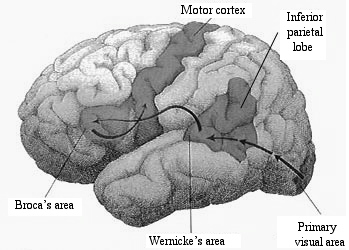Part of the brain on the top side of the head, just above the ear, which is involved in understanding where things are in space and is also in comparing equivalences in actions performed by ourselves and other people during imitation tasks. It also plays a role in keeping track of who produces an action (self versus other), and thus is believed to be implicated in determining ‘agency’. It is thus forms part of the ventral stream in distinction to the dorsal stream. Lesions in the right IPL result in deficits not only in sustaining attention, but also in responding to conspicuous events as in the case of hemineglect. As for the left IPL, it has been implicated as third area involved in language, the other two being Broca’s area and Wernicke’s area. In fact, it has connections with both these latter two areas, connections which become evident about 5 to 7 years of age (see figure below). Its involvement in language development was postulated over 40 years ago by Norman Geschwind (1926-1984), and consequently it is sometimes referred to as Geschwind’s area or territory. Certainly, the left IPL is replete with multimodal connections (auditory, visual and others) that make it functionally geared toward apprehending the diverse properties of both the spoken and written word.

Inferior parietal lobe relative to other cortical areas, showing its connections with both Broca’s area and Wernicke’s area. It also is constitutes part of the ventral stream (here given as primary visual area to inferior parietal lobe connection).
See Agentic processes, Cerebral cortex (functions), Cortical lobes, Dorsal visual pathway (or stream), Imitation, Inferior temporal cortex, Mirror neurons, Parietal cortex, Primary sensory cortices, Primary visual cortex (V1), Ventral visual pathway (or stream), Two visual systems, Wernicke’s area